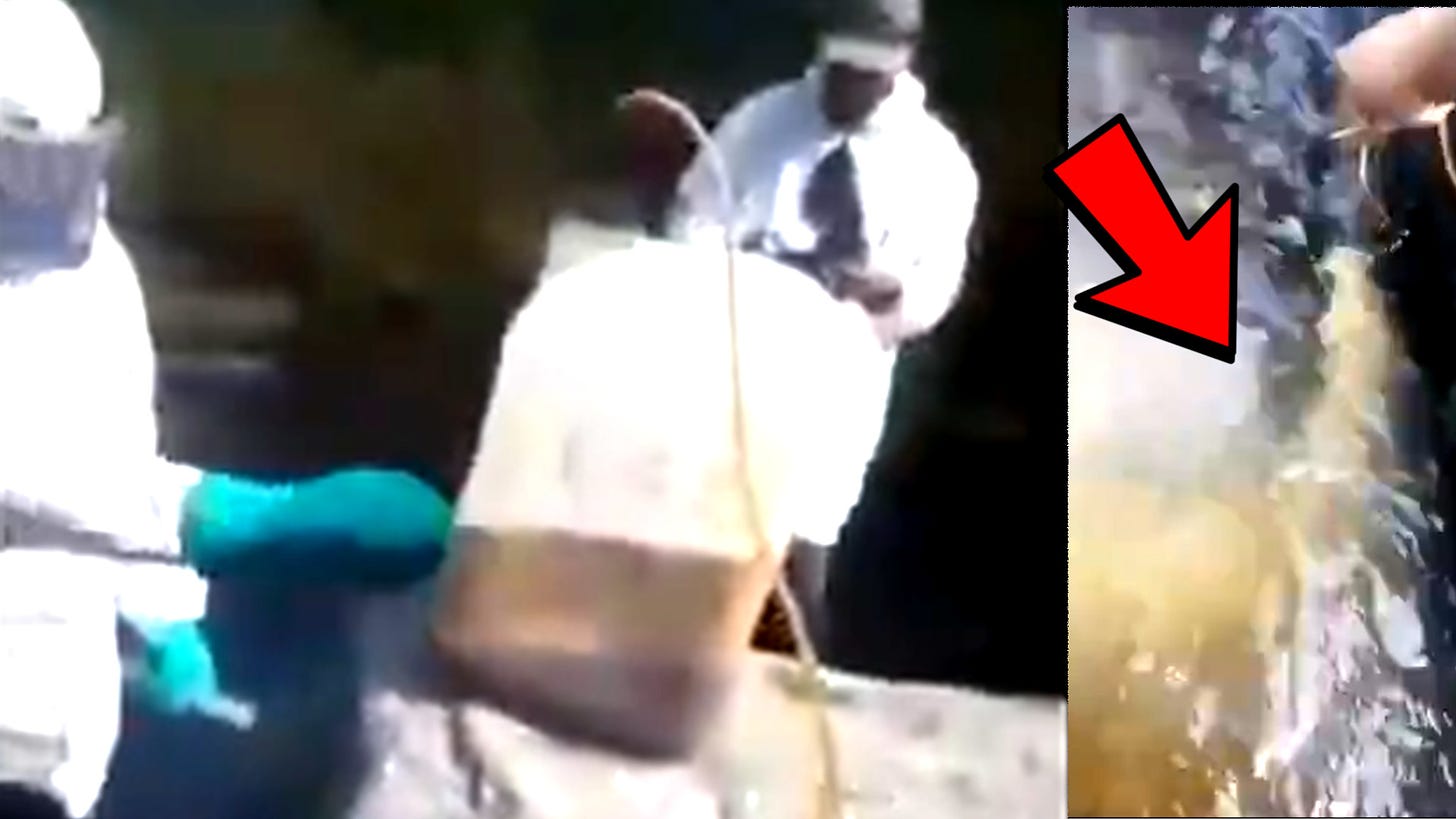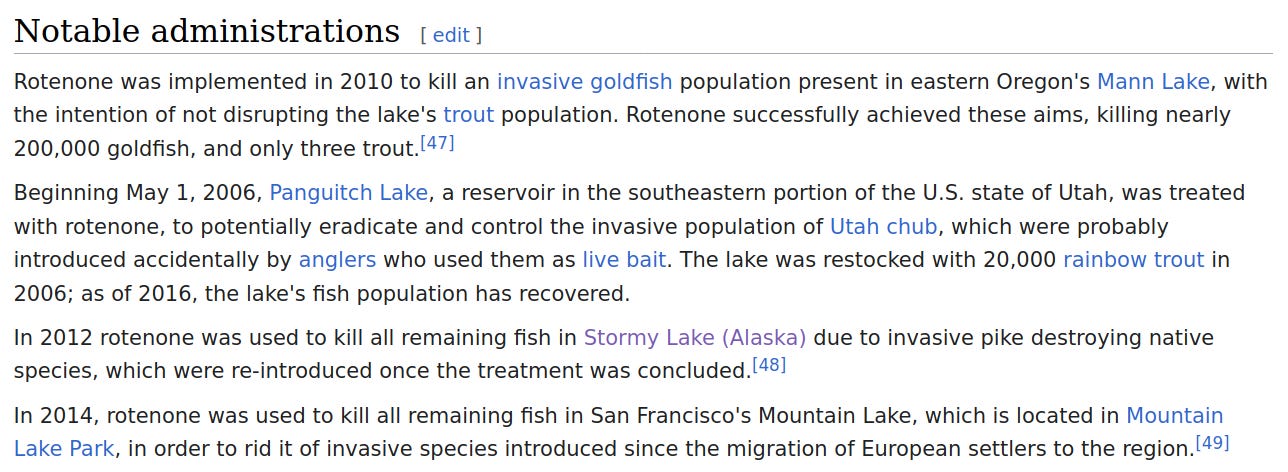POISONED WATERS: Parkinson's Associated Poison Massively Dumped Into Freshwater Around The World
The Deadly Chemical Rotenone Is Dangerously Applied To Rivers And Streams
Rotenone Blamed For Parkinson’s Disease Diagnosis In Two Pesticide Workers
In an article on the Sante Fe New Mexican called ‘Two hydrologists blame toxin used to kill fish for Parkinson's diagnoses’ Rebecca Moss details the story of two persticide workers coming down with Parkingson’s disease after being exposed to rotenone on a river fish genocide mission:
“A team of government workers, wearing thick gloves and respiratory masks, began to pour 2,200 gallons of milky white liquid into the Chicago Sanitary and Ship Canal in Illinois… the bodies of tens of thousands of fish flapped at the water’s surface, convulsing violently before growing lifeless"
“They were told the chemical, known as rotenone, was not toxic to humans, only to fish. They were told protective clothing was not necessary. But Jackson still recalls the potent chemical scent that accompanied the poison, and the way a steam vapor hung over the water”
“Jackson’s right hand began shaking uncontrollably — tremors that ultimately came to affect his entire body and have not stopped since.”
Jackson was later diagnosed with Parkinson’s.
“His colleague, Johnson, also would be diagnosed with Parkinson’s disease within two years of working with the chemical.”
Rotenone Is Used To Simulate Parkinson’s In Rats For Drug Research
Rotenone is commonly employed in a rat model of Parkinson's disease to replicate some of the key neuropathological features observed in human Parkinson's patients. Numerous studies have shown that administration of rotenone to rats replicates several key features of Parkinson's, including: selective degeneration of nigrostriatal dopaminergic neurons, aggregation of α-synuclein proteins & motor impairments similar to Parkinson's symptoms.
Rats exposed to rotenone exhibit progressive motor deficits, such as bradykinesia, rigidity, and postural instability, resembling the motor symptoms observed in human Parkinson's patients
Related Studies:
‘Using Rotenone to Model Parkinson’s Disease in Mice: A Review of the Role of Pharmacokinetics’ by Innos & Hickey (link)
‘Mechanism of Toxicity in Rotenone Models of Parkinson's Disease’ by Sherer et al (link)
‘Rotenone destroys dopaminergic neurons and induces parkinsonian symptoms in rats’ (link)
Chronic rotenone exposure reproduces Parkinson's disease gastrointestinal neuropathology (link)
Association Between Rotenone Exposure and Parkinson’s
In a paper called ‘Rotenone, Paraquat, and Parkinson’s Disease’ by Tanner et al researchers sent a survey to 84,740 people, mostly farmers residing in Iowa or North Carolina.
“In 110 Parkinson’s Disease cases and 358 controls, Parkinson’s Disease was associated with use of a group of pesticides that inhibit mitochondrial complex I [odds ratio (OR) = 1.7] including rotenone (OR = 2.5)and with use of a group of pesticides that cause oxidative stress (OR = 2.0), including paraquat (OR = 2.5).”
“This study provides strong evidence of an association between rotenone use and Parkinson’s Disease in humans. Parkinson’s Disease developed 2.5 times as often in those who reported use of rotenone compared with nonusers, and an association of similar magnitude was observed even when exposure was truncated up to 15 years before Parkinson’s Disease diagnosis”
Mass Use Of Rotenone
In a paper called ‘Rotenone Use in North America (1988–1997)’ by William McClay:
“Manipulation of fish communities to maintain sport fisheries and quantification of fish populations (sampling) were the most common uses of rotenone by North American fish and wildlife agencies”
“A total of 95 questionnaires were sent to 68 United States and 20 Canadian agencies, the District of Columbia, and 7 U.S. Fish and Wildlife Service offices.. Of the 78 responding agencies, 48 (62%) reported using rotenone in the last 10 years (1988–1997). Rotenone was used in 37 states (77%) and 5 provinces or territories (42%) during the survey period.”
Lethal Doses Of Rotenone In Humans & Rats
According to the INCHEM page on Rotenone toxicity:
Humans: “Mean lethal oral dose is about 0.3 to 0.5 g/kg” (Gosselin, 1984)
Rats: Oral lethal dose is between 60 and 132 mg/kg
“I don’t give a shit who approved it. It’s killing my cattle.” John Dutton
Young Girl Dies After Rotenone Poisoning
There’s a very concerning case report called ‘A case of fatal rotenone poisoning in a child’ by Wilde et al. I’ll update this section once I aquire the paper but here’s a reference to the results via another paper:
Fatality After Ingestion Of 25 mg/kg Rotenone
In a case report called ‘Fatality after deliberate ingestion of the pesticide rotenone’ by Wood et al, researchers detail the incident of a woman dying after consuming 25 mg/kg rotenone
The woman was “found collapsed and unconscious at home by her family, with a history of vomiting” and was broght to an ER in a deep coma (Glasgow Coma Scale 3/15, meaning minimal or no response to stimuli)
“At 48 hours after admission she suffered an asystolic cardiac arrest, which did not respond to cardiopulmonary resuscitation. At postmortem there were signs of multiorgan failure, with pulmonary oedema and congestion of the heart, spleen and kidneys. The liver was icteric with centrilobular necrosis and general disintegration.”
Recent Mass Deployments:
This is a very small subset of all the fish kill operations but I wanted to include this section to give an impression of how prevalent this barbaric practice is.
Montana
‘Yellowstone Series: Government Uses Poison Linked to Parkinson’s in Montana Waterways Since 1948’ https://publicherald.org/yellowstone-series-government-uses-poison-linked-to-parkinsons-in-montana-waterways-since-1948/
“In August of 2022, Montana Fish, Wildlife and Parks (FWP) administered the fourth round of a fish-killing chemical poison, rotenone, to the North Fork of Spanish Creek, a tributary to the Gallatin River watershed outside of Bozeman, Montana.”
“Since 2019, FWP has been applying rotenone using backpack sprayers and drip stations to the North Fork of Spanish Creek”
“FWP records obtained by Public Herald show that since 1948 Montana agencies have applied rotenone 253 times at more than 200 different water bodies, to an estimated length of 533 miles of surface water throughout the state.”
Wyoming, USA [Sept 2022]
‘Fish kill raises questions about what species belong’: https://www.wyodaily.com/story/2022/12/01/news/fish-kill-raises-questions-about-what-species-belong/13819.html
“In September [2022], the Wyoming Game and Fish Department applied 14,000 pounds of a chemical called rotenone to kill anything with gills in Saratoga Lake. “
Washington, USA [Nov 2022]
‘Fish & Wildlife kill carp at ponds south of Pasco. Watch for eagles flocking in to feast’ https://www.tri-cityherald.com/sports/outdoors/article268429907.html
Utah, USA [August 2019]
‘Upcoming Rotenone Treatments In Uinta Mountains To Help Conserve Cutthroat Trout’ https://www.upr.org/environment/2019-08-14/upcoming-rotenone-treatments-in-uinta-mountains-to-help-conserve-cutthroat-trout
“Beginning August 28, the Utah Division of Wildlife Resources will be adding rotenone to several lakes and streams in the Eastern Uinta Mountains”
Idaho, USA [2023]
‘Castle Rocks State Park Fishing Pond to close to remove illegally introduced goldfish’: https://idfg.idaho.gov/press/castle-rocks-state-park-fishing-pond-close-remove-illegally-introduced-goldfish
Arizona, USA [Sept 2022]
‘Park Service to poison bass upstream of Grand Canyon to save native fish’: https://www.azcentral.com/story/news/local/arizona-environment/2022/09/12/biologists-plan-poison-bass-threaten-grand-canyon-chubs/10360646002/
‘NPS to poison non-native fish below Glen Canyon Dam’: https://www.williamsnews.com/news/2022/sep/20/nps-poison-non-native-fish-below-glen-canyon-dam/
New Mexico, USA
‘Worries linger over pesticide to be used in Gila trout reintroduction’ https://www.santafenewmexican.com/news/local_news/worries-linger-over-pesticide-to-be-used-in-gila-trout-reintroduction/article_eb72211b-cd0c-5a4a-b70a-5c867d7ea78a.html
Colorado, USA
‘Colorado wildlife managers plan to kill off existing fish, restock lake with native trout’: https://www.cbsnews.com/colorado/news/state-wildlife-managers-poison-rotenone-fish-restock-lake-rio-grande-native-trout-rito-hondo-reservoir-cpw/
CPW personnel will begin treatments with the chemical at Rito Hondo Reservoir on July 24
"These projects are very common across the state," CPW Aquatic Biologist told CBS News Colorado. "This year alone, there are six projects planned statewide.
Nebraska, USA
‘Hackberry Lake undergoing chemical renovation’ https://www.klkntv.com/hackberry-lake-undergoing-chemical-renovation/
Nova Scotia, Canada
‘Pesticide used in attempt to eradicate invasive fish species in Nova Scotia lake’: https://www.theglobeandmail.com/canada/article-pesticide-used-in-attempt-to-eradicate-invasive-fish-species-in-nova/
New Brunswick, Canada
New Brunswick pumping Rotenone poison into a lake to kill all the fish: https://www.bitchute.com/video/a4uhFSsYeLj9/
Concerning Tumors After Rotenone Exposure In Animals
In a paper called ‘CARCINOGENESIS WITH THE INSECTICIDE ROTENONE’ by Mario Gosálvez (full report)
“It is strongly suspected that rotenone is carcinogenic to the rat (at doses from 2 to 25 parts per million continuously in food or from 0.8 to 2.5 mg/kg weight for 1 to 4 month by oral administration), above all, when the rats receive deficient diets, especially those deficient in riboflavin”
“The total yearly consumption of rotenone in the U.S.A is presently estimated at 15 million pounds”
“A few studies on the subacute toxicity of rotenone-containing powders (0.6 to 9.6% of rotenone..) to dogs, cats and rats appeared from 1931 to 1943, and concluded that rotenone, when fed to these animals for 100 to 200 days, caused growth retardation and fatty degeneration of the liver at levels of 75 ppm and above in the diet.”
Scientists noted masses in rats livers at 2 to 10 parts per million rotenone in the rats’ diets.
“A.J Lehman.. in 1952 reported that the pricipal gross effect of chronic rotenone feeding in the rat was growth retardation and increased incidence of hepatic tumors. The principle histo-pathological change encountered were peculiar hepatic cell masses of 0.5 to 1 cm, which were classified between hyperplasia and tumor”
“An internal report of the U.S. Food and Drug Administration from Dr. E. L. Long to Dr. A. J. Lehman, dated July 31, 1959, reported work performed several years before on the feeding of male and female Osborne-Mendel rats for two years with pure rotenone in the diet, at levels of 2, 5, 10, 25, 50 and 100 parts per million. This report described a retardation of growth which was proportional to the dose, which started to be significant at 50 parts per million in the females and at 100 parts per million in the males. An increasing incidence of a great variety of tumors at all rotenone diet levels was observed with respect to the control diet... The only significant finding … an abnormal incidence of hepatic cell tumors (carcinoma, Adenoma and hyperplasic modules), which occurred at the levels of 2, 5 and 10 parts per million, but not at higher levels.”
“The general incidence of the great variety of tumors reached a peak at the 5 parts per million level of rotenone ingestion (41% tumor incidence)”
“Over the years, rotenone has shown the ability to induce preneoplastic, paraneoplastic and neoplastic lesions in rats in some experiments carried out by different investigators”
“We strongly suggest that rotenone is carcinogenic for the rat after oral administration of critical dosages”








No comments:
Post a Comment